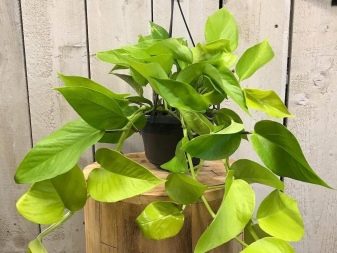Cultivation of golden epipremnum

Growing Epipremnum aureus can be very attractive to many gardeners. However, you will have to carefully study the features of caring for it at home, find out what diseases and pests threaten this plant. It will also be interesting to understand reproduction, with the term devil's gold and other names for a hanging indoor flower.


Description of the flower
From a biological point of view, golden epipremnum - it is a type of deciduous climbing plant. It is customary to refer it to the genus Epipremnum of the same name, which is part of the aroid family. Botanists have not yet established whether this is definitely a separate species, or is it a subspecies of the feathery epipremnum. But the region of origin was established for sure - this is French Polynesia. In the interior, such a plant is used all over the world.
Often it is not cultivated in simple soil, but by the hydroponic method. This further expands the application of the original hanging culture. In sources devoted to gardening, this species is mentioned under a number of other names. It is called:
- sweat;
- golden sweat;
- scindapsus (including golden scindapsus - although from a botanical point of view this is obviously incorrect).


Indoor aureum is another popular synonym. The alternative is the devil's gold. In both cases, the terms are used for trade promotion purposes.
Epipremnum is a herbaceous species that rises due to adventitious roots, along which stems rise. The total size of the liana is not so large - up to 1-2 m.
The foliage is of a solid structure, shaped like a heart. The length of the leaves is 10-15 cm. It has a leathery structure. Green color with golden inclusions is typical. Individuals growing in the sun have a more intense yellow color than those developed in the shade.


A feature of golden epipremnum is the ability to absorb water from the air and release it in drops at the edges of the leaves. It has been found that this species removes formaldehyde and other toxic volatile gases from the air. Therefore, it can be recommended for providing a favorable atmosphere in buildings in large cities. In nature, golden epipremnum grows in:
- Indochina;
- PRC;
- Malaysia;
- northern regions of Australia;
- in the Solomon Islands.


Most often, it inhabits tropical rainforests.
In everyday life, this species is also called "damn ivy". The ability to grow quickly and acquire a graceful appearance is noted.
In nature, golden epipremnum grows up to 30 m. The size of the leaf plates is due to the intensity of sunlight.
The specific name - golden - is given by color. A noticeable amount of yellow-golden spots and stripes are scattered on the leaf plate. When grown in a room, epipremnum can be kept in juvenile form for a long time. Then it looks more like a bush than a liana in the conventional form. The leaves will be no longer than 10 cm and are characterized by short petioles.


There are a number of varieties of golden epipremnum:
- "Neon" (with rich lemon foliage, fast growing);
- "N Joy" (having a small-sized crown, covered with fleshy leaves up to 5 cm wide and up to 8 cm long);
- "Marble Queen" or "Marble Queen" - silvery green unpretentious type;
- "Happy Leaf" (with the lightest color of silvery spots).


Planting and leaving
The cultivation of golden epipremnum at home is aimed mainly for decorative and deciduous use. In nature, it blooms willingly, but in a room it will be extremely difficult to achieve this. The variegated plant will delight you with a pleasant color in good light. Green-leaved varieties also develop in low shade. But in any case, the culture needs shading.
Growing epipremnum is possible in a standard temperature regime, just in a room. However, drafts and piercing winds can destroy a culture. Watering should go immediately after the top layer of the potting mix dries. In this case, irrigation should be carried out in moderation. When using heating devices, including batteries, you will need to use a spray bottle to spray the leaves.


Top dressing should be applied in April - September every 14 days. It is best to use a liquid liana mineral fertilizer. Half as often, feeding should be carried out during the rest period. This period is not very pronounced, it falls on October - March. Direct sunlight is extremely harmful to the epipremnum; best of all are the east and west windows, from where a bright but diffused light flux comes from.
Due to the exposure to drafts, the bushes of such a plant are impractical to take out to gardens or balconies. Instead, the room is ventilated. Irrigation activity is reduced if water drops appear on the back of the foliage.
For irrigation, use soft water, including filtered water. The transplant is carried out only as needed.


Reproduction
Liana epipremnum is recommended to be propagated by cuttings. At least 2 leaves grow on a good cutting. The planting material is placed in a peat and moss substrate. It is necessary to keep such a culture at 20-22 degrees. The containers are covered with glass or polyethylene.
In some cases, the cuttings are placed in a reservoir of water. When the roots are formed, the plant is transplanted into a flowerpot. Using layering involves attaching the shoot to the surface in an adjacent pot. After the formation of the roots, the layers are separated.
It is most difficult to resort to dividing the shoot; all divisions should have at least 1 sheet, and such blanks are kept in a tank in a dark place, without watering, until roots are formed, again.


Diseases and pests
Scales and thrips can affect the golden epipremnum. Spider mites are also dangerous. These insects harm the leaf blades. Affected leaves turn yellow and degrade. After removing harmful individuals from the plant using a soap solution, which is impregnated with a sponge, the culture is treated with a diluted insecticide.
Root decay is often provoked by waterlogging of soil substrates. This is manifested when the leaves turn yellow and rot forms. Lack of nutritional components leads to inhibition of growth. Excessively low temperature provokes darkening of the edge of the sheet. Spraying with infusion of orange peel helps to fight aphids.
Insecticidal preparations are ineffective against the scabbard. Spraying gives a worse result than wetting a piece of cloth with the composition and peeling the insect off with your hands. Spider mites are washed off with a warm shower. Only if this does not work, it is worth using branded insecticides.


Following these relatively simple guidelines will produce a good plant.

























The comment was sent successfully.